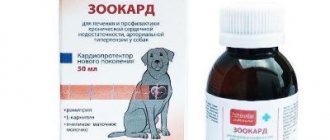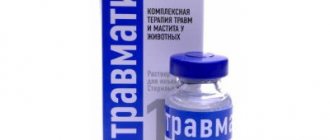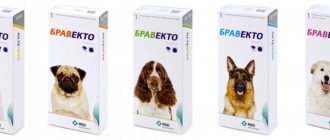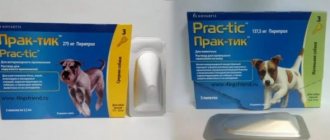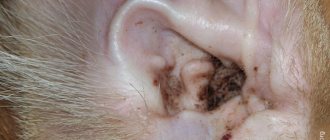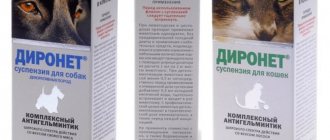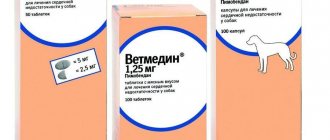Severe viral diseases in dogs are difficult, time consuming and expensive to treat. And the outcome is often unfavorable. Therefore, the owners agree to any therapy and, in a panic, do not really think about what medications the veterinarian prescribes. Often, to reassure animal owners and increase the chances of recovery, doctors prescribe immunomodifiers. One of them is Maxidin.
In this review, we’ll figure out how and why Maxidin works, whether it really helps, what analogues there are, and whether it’s worth using.
At the end of the article you will find answers to your questions and my conclusion regarding immunomodulators.
Can it be used?
The drug Maxidin is a water-based antiviral eye drops and solution for injection. The drug is used in therapy and for the prevention of canine diseases.
The medicine has the following properties:
- increasing the body's resistance to disease;
- prevention of viral diseases;
- improving the functionality of the lymphatic system;
- stimulation of the production of natural interferon;
- acceleration of oxidative metabolism.
Veterinarians often prescribe medication for dogs with parvovirus enteritis and canine distemper.
Composition and release form
The product is presented in the form of a clear, colorless and odorless liquid, which is bottled in glass bottles. One package contains five bottles.
The main active element is BPDH or bis. This component prevents further proliferation of viral cells, enhances phagocytosis, accelerates oxidative metabolic processes and improves the functioning of the lymphatic system.
Excipients: chloride, monoethanolamine, water.
Instructions for use
Drops 0.15 in eyes
Maxidin drops are prescribed for infectious and allergic eye diseases (conjunctivitis and keratoconjunctivitis). Place 2 drops into each eye using a pipette 2-3 times a day.
If the dog is calm, you need to proceed according to the following scheme:
- Secure the dog (if the animal is small, you can hold it between your knees; if it is large, sit it down, then stand behind it).
- Clean the area around the eyes with a cotton pad soaked in water and remove discharge from the eyes.
- Hold the dog by the lower jaw with one hand, and place the other with the medicine on the head.
- Raise the animal's head a little and drip onto the eyeball.
- After instillation, gently massage the upper eyelid.
- At the end of the manipulation, praise the animal and give it a treat.
If the dog is aggressive, it should be muzzled or its mouth covered with a bandage.
After the manipulation, you need to make sure that the dog does not rub its eyes with its paw or scratch its head on objects.
Into the nose
An immunomodulatory agent is prescribed for infectious diseases of the upper respiratory tract (rhinitis). Instill 2 drops into each nostril using a pipette 2-3 times a day until complete recovery.
Drops are applied into the nose in the same way as into the eyes. The animal must be secured. If it is difficult to get the pipette into the nostril, you can draw the required amount of medicine into a syringe, remove the needle and inject the drug. After the procedure, the dog should be praised and given its favorite treat.
Solution for injection 0.4
Maksidin in the form of an injection solution is a colorless transparent liquid. It is used for the treatment and prevention of viral infections. The solution has immunomodulatory and antiviral effects, increases the effectiveness of immune cells. The drug is indicated for the treatment of dermatitis and alopecia of various etiologies.
Maxidin 0.4 is administered subcutaneously or intramuscularly 2 times a day for 2-5 days. The dosage depends on the weight of the animal:
- up to 5 kg – 0.5 ml;
- 10 kg – 1 ml;
- 20 kg – 2 ml;
- 40 kg – 4 ml;
- more than 40 kg – 4-6 ml.
The drug can be used as part of complex therapy.
Side effects
There have been no documented cases of side effects in dogs when instructions are followed exactly. In isolated cases, individual intolerance to the components of the drug in the form of allergic reactions was observed.
If you notice allergy symptoms in your dog within half an hour after using Maxidin, you should give him an antihistamine and stop further use of the solution.
Reviews
Owners
Elena, 34 years old, Moscow:
“I never thought that dogs have a runny nose. The veterinarian recommended another drug, but it was not available in veterinary pharmacies. One of them offered a replacement in the form of Maksidin. The bottle has a rubber stopper and a metal cap. But there is no pipette, I had to go to a regular pharmacy.
Treatment started on the second day. You need to drip 3 times a day; I put a drop in each nostril for my Spitz. He didn't like it. Got rid of a runny nose after 5 days of treatment. These drops are also put into the eyes for conjunctivitis.”
Elizaveta, 29 years old, Ekaterinburg:
“About two months ago, a puppy fell ill. The diagnosis was made of rhinotracheitis. The disease did not occur in an acute form, but was chronic. It all started with periodic sneezing, after a while the eyes began to water, and discharge from the nose appeared.
The puppy was 2 months old at the time, and the most gentle treatment was prescribed. In addition to the antiviral drug in the form of injections, Maksidin 0.15 solution was also added in the form of eye and intranasal drops.
I have never encountered this drug before. It not only helps treat rhinitis and conjunctivitis, but also has an immunomodulatory effect and produces interferon. The puppy was problematic almost from birth, probably picked up an infection while still with the bitch. Maksidin began to act positively. The discharge from the nose and eyes stopped, and the puppy recovered.
Drops were instilled 1 into the eyes and into each nasal passage 3 times a day. The puppy tolerated this procedure relatively well. It would be more problematic with an adult animal.
Drops can be used intranasally to enhance immunity.”
Vet
Lydia, 44 years old, veterinarian, St. Petersburg:
“I often use Maxidin in my practice when working with small pets. After the injections, the dog’s body coped with infections of viral origin faster. The drug is painful, but effective.”
Answers to frequently asked questions
Is Maksidin allowed to be used by pregnant dogs?
The instructions do not contain any restrictions on use for puppy dogs. It does not affect pregnant dogs, nor does it affect fetuses and babies during natural feeding.
Are there any restrictions for use in puppies?
The drug should not be administered to kittens up to two months old. From 4 weeks, the drug is used with caution and only in case of urgent need. In this case, supervision and control of a veterinarian is required.
Can the dosage be increased or decreased?
The instructions for use clearly state the doses. But doctors recommend reducing them if Maxidin is used simultaneously with other IMDs, or increasing them in case of severe viral diseases. Don't do this yourself! The decision is made by the veterinarian.
Can I use the drug on my own?
The drugs are sold without a veterinary prescription. However, it is prohibited to use it without a doctor's prescription. Do not use the drug yourself: at best, you will waste your energy and money, at worst, you will aggravate the animal’s condition.
Precautionary measures
The medicinal composition of the drug "Maksidin" should not cause unpredictable reactions in your pet. If the animal is immune to some of the components of this drug or there are signs of an allergic reaction, it is necessary to discuss with your veterinarian the possibility of replacing Maksidin with other drugs.
Some standard precautions must be taken when performing health activities:
- immediately before treatment, all crusts, pus and dirt must be carefully removed;
- the puncture site on the rubber cap of the bottle is pre-treated with alcohol;
- the instruments used must be sterile.
Therapeutic measures are carried out only with medical rubber gloves. Immediately after performing the treatment procedure, hands should be thoroughly treated with any disinfectant composition.
This is interesting! The standard shelf life of the medicinal composition "Maksidin" is two years from the date of release, subject to all rules for storing the drug.
Return to content
Consumer Opinions
Reviews of Maxidin for cats are on average positive. Buyers note the speed of action and effectiveness.
- Maxidin eye drops show themselves to be more effective than their analogues.
- After 2-3 days, kittens and adult cats have practically clear eyes; it is great for preventing runny noses, especially in animals undergoing rehabilitation.
- A course of drops will prevent coughing and sneezing from developing into severe forms.
It works well for viral rhinotracheitis in combination with local antibiotics (for example, Tsiprovet).
- Pros: Versatility, drops are suitable for both the nose and eyes, well tolerated by animals, does not sting, low price. A package of 5 bottles of 5 ml costs 200-400 rubles, 1 bottle, which is usually enough for 1 animal - 50-60 rubles.
- The drug is indispensable for Persian or exotic cats. These animals, due to the structure of their muzzle, often suffer from brachycephalic airway obstruction syndrome and constant lacrimation. Treatment in courses of 2 weeks can provide the animal with a month of complete comfort with the eyes and nose.
- The downside is that the packaging is not very convenient - there is no pipette.
- Occasionally, allergic reactions occur: swelling, even more profuse lacrimation from the eyes.
In very rare reviews, the product is described as having no effect.
In any case, you should carefully monitor the condition of your own pet in order to adjust treatment in time. It is advisable to select medications together with a veterinarian.
Pharmacological group
| Category ICD-10 | Synonyms of diseases according to ICD-10 |
| I10 Essential (primary) hypertension | Arterial hypertension |
| Arterial hypertension | |
| Arterial hypertension of crisis course | |
| Arterial hypertension complicated by diabetes mellitus | |
| Arterial hypertension | |
| Sudden increase in blood pressure | |
| Hypertensive circulatory disorder | |
| Hypertensive state | |
| Hypertensive crises | |
| Hypertension | |
| Arterial hypertension | |
| Hypertension is malignant | |
| Essential hypertension | |
| Hypertonic disease | |
| Hypertensive crises | |
| Hypertensive crisis | |
| Hypertension | |
| Malignant hypertension | |
| Malignant hypertension | |
| Isolated systolic hypertension | |
| Hypertensive crisis | |
| Exacerbation of hypertension | |
| Primary arterial hypertension | |
| Transient arterial hypertension | |
| Essential arterial hypertension | |
| Essential arterial hypertension | |
| Essential hypertension | |
| Essential hypertension | |
| I15 Secondary hypertension | Arterial hypertension |
| Arterial hypertension | |
| Arterial hypertension of crisis course | |
| Arterial hypertension complicated by diabetes mellitus | |
| Arterial hypertension | |
| Vasorenal hypertension | |
| Sudden increase in blood pressure | |
| Hypertensive circulatory disorder | |
| Hypertensive state | |
| Hypertensive crises | |
| Hypertension | |
| Arterial hypertension | |
| Hypertension is malignant | |
| Hypertension, symptomatic | |
| Hypertensive crises | |
| Hypertensive crisis | |
| Hypertension | |
| Malignant hypertension | |
| Malignant hypertension | |
| Hypertensive crisis | |
| Exacerbation of hypertension | |
| Renal hypertension | |
| Renovascular arterial hypertension | |
| Renovascular hypertension | |
| Symptomatic arterial hypertension | |
| Transient arterial hypertension |
Pharmacokinetics
Suction. After oral administration, moxonidine is rapidly and almost completely absorbed from the upper gastrointestinal tract. Absolute bioavailability is approximately 88%. Tmax is about 1 hour. Food intake does not affect the pharmacokinetics of the drug.
Distribution. The binding to plasma proteins is 7.2%.
Metabolism. The main metabolite is dehydrogenated moxonidine. The pharmacodynamic activity of dehydrogenated moxonidine is about 10% of that of moxonidine.
Elimination T1/2 of moxonidine and metabolite is 2.5 and 5 hours, respectively. Within 24 hours, over 90% of moxonidine is excreted by the kidneys (about 78% unchanged and 13% as dehydromoxonidine, other metabolites in the urine do not exceed 8% of the dose taken). Less than 1% of the dose is excreted through the intestines.
Special patient groups
Arterial hypertension. Compared with healthy volunteers, patients with arterial hypertension do not show changes in the pharmacokinetics of moxonidine.
Elderly age. Clinically insignificant changes in the pharmacokinetic parameters of moxonidine were noted in elderly patients, probably due to a decrease in the intensity of its metabolism and/or slightly higher bioavailability.
Children. Moxonidine is not recommended for use in patients under 18 years of age, and therefore pharmacokinetic studies have not been conducted in this group.
Kidney failure. Moxonidine excretion is significantly correlated with creatinine clearance. In patients with moderate renal failure (Cl creatinine 30–60 ml/min), plasma Css and final T1/2 are approximately 2 and 1.5 times higher than in patients with normal renal function (Cl creatinine more than 90 ml/min ).
In patients with severe renal failure (Cl creatinine less than 30 ml/min), plasma Css and final T1/2 are 3 times higher than in patients with normal renal function. The administration of multiple doses of moxonidine leads to predictable accumulation in the body of patients with moderate and severe renal failure.
In patients with end-stage renal failure (Cl creatinine less than 10 ml/min) on hemodialysis, plasma Css and final T1/2 are 6 and 4 times higher, respectively, than in patients with normal renal function. In all groups, the Cmax of moxonidine in blood plasma is 1.5–2 times higher. In patients with impaired renal function, the dosage should be adjusted individually. Moxonidine is excreted to a small extent during hemodialysis.
special instructions
The use of an antihypertensive drug for therapeutic purposes requires constant monitoring of blood pressure, heart function and heart rate.
During the course of treatment, you should completely avoid alcoholic beverages. It is recommended not to drive vehicles or engage in activities that require concentration, memory and high mental activity.
You need to stop taking the drug gradually, gradually reducing the dose until complete withdrawal.
If the use of Moxonidine was combined with beta-blockers and it is necessary to discontinue both drugs, the latter are removed first. After some time, the antihypertensive drug is discontinued.
Cost of maxidin for dogs
The immunomodulatory drug "Maksidin", used for eye diseases and pathologies of the respiratory tract of infectious and allergic origin, is produced in 5 ml glass bottles, which are placed in five pieces in standard cardboard boxes.
You can purchase the veterinary drug "Maksidin" in a whole package or individually. The average cost of one bottle is about 50-60 rubles, and the average cost of a whole package is about 250-300 rubles.
Return to content
Contraindications
Contraindications for the use of the drug "Maksidin" include the presence of individual hypersensitivity to the components of the drug in the dog . It is strictly forbidden to use the drug if the bottle of medicine contains any mechanical impurities, the integrity is compromised, or a change in color or clouding of the solution is noted. Vials with expired expiration dates are also subject to mandatory rejection and subsequent disposal.
Return to content
Properties of the drug
The drug has quite high effectiveness both for the treatment of diseases and during prevention. Excellently improves the performance of the immune system. These characteristics are due to its properties.
After the active substance penetrates into the cell, stimulation of the animal’s natural resistance to various pathogenic microorganisms begins. Immune resistance is also strengthened. The drug Maxidin is also a good anti-inflammatory and antiviral agent.
This medicine provokes the formation of interferon . It prevents viral proteins from developing, which prevents pathogens from multiplying in healthy cells of the body.
The medication destroys the virus without causing any harm to the cat.
A very important feature of Maxidin is that it greatly enhances the functioning of the immune system due to the activation of macrophages. This stimulates the destruction of foreign bodies and improves metabolism.


